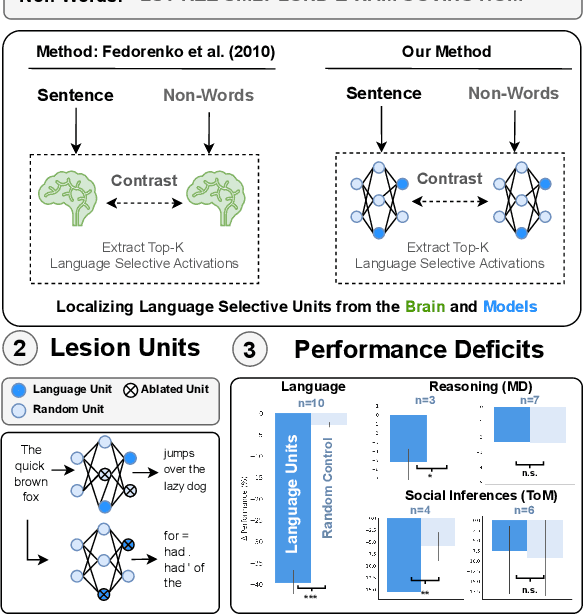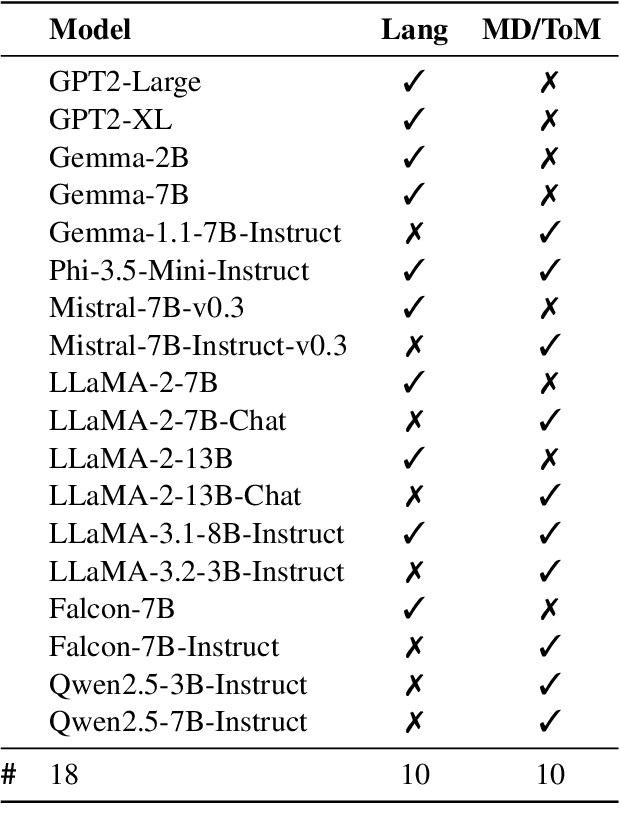Antoine Bosselut
VinaBench: Benchmark for Faithful and Consistent Visual Narratives
Mar 26, 2025Abstract:Visual narrative generation transforms textual narratives into sequences of images illustrating the content of the text. However, generating visual narratives that are faithful to the input text and self-consistent across generated images remains an open challenge, due to the lack of knowledge constraints used for planning the stories. In this work, we propose a new benchmark, VinaBench, to address this challenge. Our benchmark annotates the underlying commonsense and discourse constraints in visual narrative samples, offering systematic scaffolds for learning the implicit strategies of visual storytelling. Based on the incorporated narrative constraints, we further propose novel metrics to closely evaluate the consistency of generated narrative images and the alignment of generations with the input textual narrative. Our results across three generative vision models demonstrate that learning with VinaBench's knowledge constraints effectively improves the faithfulness and cohesion of generated visual narratives.
From Language to Cognition: How LLMs Outgrow the Human Language Network
Mar 03, 2025Abstract:Large language models (LLMs) exhibit remarkable similarity to neural activity in the human language network. However, the key properties of language shaping brain-like representations, and their evolution during training as a function of different tasks remain unclear. We here benchmark 34 training checkpoints spanning 300B tokens across 8 different model sizes to analyze how brain alignment relates to linguistic competence. Specifically, we find that brain alignment tracks the development of formal linguistic competence -- i.e., knowledge of linguistic rules -- more closely than functional linguistic competence. While functional competence, which involves world knowledge and reasoning, continues to develop throughout training, its relationship with brain alignment is weaker, suggesting that the human language network primarily encodes formal linguistic structure rather than broader cognitive functions. We further show that model size is not a reliable predictor of brain alignment when controlling for feature size and find that the correlation between next-word prediction, behavioral alignment and brain alignment fades once models surpass human language proficiency. Finally, using the largest set of rigorous neural language benchmarks to date, we show that language brain alignment benchmarks remain unsaturated, highlighting opportunities for improving future models. Taken together, our findings suggest that the human language network is best modeled by formal, rather than functional, aspects of language.
DRIVINGVQA: Analyzing Visual Chain-of-Thought Reasoning of Vision Language Models in Real-World Scenarios with Driving Theory Tests
Jan 08, 2025



Abstract:Large vision-language models (LVLMs) augment language models with visual understanding, enabling multimodal reasoning. However, due to the modality gap between textual and visual data, they often face significant challenges, such as over-reliance on text priors, hallucinations, and limited capacity for complex visual reasoning. Existing benchmarks to evaluate visual reasoning in LVLMs often rely on schematic or synthetic images and on imprecise machine-generated explanations. To bridge the modality gap, we present DrivingVQA, a new benchmark derived from driving theory tests to evaluate visual chain-of-thought reasoning in complex real-world scenarios. It offers 3,931 expert-crafted multiple-choice problems and interleaved explanations grounded with entities relevant to the reasoning process. We leverage this dataset to perform an extensive study of LVLMs' ability to reason about complex visual scenarios. Our experiments reveal that open-source and proprietary LVLMs struggle with visual chain-of-thought reasoning under zero-shot settings. We investigate training strategies that leverage relevant entities to improve visual reasoning. Notably, we observe a performance boost of up to 7\% when reasoning over image tokens of cropped regions tied to these entities.
PICLe: Pseudo-Annotations for In-Context Learning in Low-Resource Named Entity Detection
Dec 16, 2024Abstract:In-context learning (ICL) enables Large Language Models (LLMs) to perform tasks using few demonstrations, facilitating task adaptation when labeled examples are hard to obtain. However, ICL is sensitive to the choice of demonstrations, and it remains unclear which demonstration attributes enable in-context generalization. In this work, we conduct a perturbation study of in-context demonstrations for low-resource Named Entity Detection (NED). Our surprising finding is that in-context demonstrations with partially correct annotated entity mentions can be as effective for task transfer as fully correct demonstrations. Based off our findings, we propose Pseudo-annotated In-Context Learning (PICLe), a framework for in-context learning with noisy, pseudo-annotated demonstrations. PICLe leverages LLMs to annotate many demonstrations in a zero-shot first pass. We then cluster these synthetic demonstrations, sample specific sets of in-context demonstrations from each cluster, and predict entity mentions using each set independently. Finally, we use self-verification to select the final set of entity mentions. We evaluate PICLe on five biomedical NED datasets and show that, with zero human annotation, PICLe outperforms ICL in low-resource settings where limited gold examples can be used as in-context demonstrations.
Global MMLU: Understanding and Addressing Cultural and Linguistic Biases in Multilingual Evaluation
Dec 04, 2024



Abstract:Cultural biases in multilingual datasets pose significant challenges for their effectiveness as global benchmarks. These biases stem not only from language but also from the cultural knowledge required to interpret questions, reducing the practical utility of translated datasets like MMLU. Furthermore, translation often introduces artifacts that can distort the meaning or clarity of questions in the target language. A common practice in multilingual evaluation is to rely on machine-translated evaluation sets, but simply translating a dataset is insufficient to address these challenges. In this work, we trace the impact of both of these issues on multilingual evaluations and ensuing model performances. Our large-scale evaluation of state-of-the-art open and proprietary models illustrates that progress on MMLU depends heavily on learning Western-centric concepts, with 28% of all questions requiring culturally sensitive knowledge. Moreover, for questions requiring geographic knowledge, an astounding 84.9% focus on either North American or European regions. Rankings of model evaluations change depending on whether they are evaluated on the full portion or the subset of questions annotated as culturally sensitive, showing the distortion to model rankings when blindly relying on translated MMLU. We release Global-MMLU, an improved MMLU with evaluation coverage across 42 languages -- with improved overall quality by engaging with compensated professional and community annotators to verify translation quality while also rigorously evaluating cultural biases present in the original dataset. This comprehensive Global-MMLU set also includes designated subsets labeled as culturally sensitive and culturally agnostic to allow for more holistic, complete evaluation.
INCLUDE: Evaluating Multilingual Language Understanding with Regional Knowledge
Nov 29, 2024



Abstract:The performance differential of large language models (LLM) between languages hinders their effective deployment in many regions, inhibiting the potential economic and societal value of generative AI tools in many communities. However, the development of functional LLMs in many languages (\ie, multilingual LLMs) is bottlenecked by the lack of high-quality evaluation resources in languages other than English. Moreover, current practices in multilingual benchmark construction often translate English resources, ignoring the regional and cultural knowledge of the environments in which multilingual systems would be used. In this work, we construct an evaluation suite of 197,243 QA pairs from local exam sources to measure the capabilities of multilingual LLMs in a variety of regional contexts. Our novel resource, INCLUDE, is a comprehensive knowledge- and reasoning-centric benchmark across 44 written languages that evaluates multilingual LLMs for performance in the actual language environments where they would be deployed.
The LLM Language Network: A Neuroscientific Approach for Identifying Causally Task-Relevant Units
Nov 04, 2024



Abstract:Large language models (LLMs) exhibit remarkable capabilities on not just language tasks, but also various tasks that are not linguistic in nature, such as logical reasoning and social inference. In the human brain, neuroscience has identified a core language system that selectively and causally supports language processing. We here ask whether similar specialization for language emerges in LLMs. We identify language-selective units within 18 popular LLMs, using the same localization approach that is used in neuroscience. We then establish the causal role of these units by demonstrating that ablating LLM language-selective units -- but not random units -- leads to drastic deficits in language tasks. Correspondingly, language-selective LLM units are more aligned to brain recordings from the human language system than random units. Finally, we investigate whether our localization method extends to other cognitive domains: while we find specialized networks in some LLMs for reasoning and social capabilities, there are substantial differences among models. These findings provide functional and causal evidence for specialization in large language models, and highlight parallels with the functional organization in the brain.
Creativity in AI: Progresses and Challenges
Oct 22, 2024Abstract:Creativity is the ability to produce novel, useful, and surprising ideas, and has been widely studied as a crucial aspect of human cognition. Machine creativity on the other hand has been a long-standing challenge. With the rise of advanced generative AI, there has been renewed interest and debate regarding AI's creative capabilities. Therefore, it is imperative to revisit the state of creativity in AI and identify key progresses and remaining challenges. In this work, we survey leading works studying the creative capabilities of AI systems, focusing on creative problem-solving, linguistic, artistic, and scientific creativity. Our review suggests that while the latest AI models are largely capable of producing linguistically and artistically creative outputs such as poems, images, and musical pieces, they struggle with tasks that require creative problem-solving, abstract thinking and compositionality and their generations suffer from a lack of diversity, originality, long-range incoherence and hallucinations. We also discuss key questions concerning copyright and authorship issues with generative models. Furthermore, we highlight the need for a comprehensive evaluation of creativity that is process-driven and considers several dimensions of creativity. Finally, we propose future research directions to improve the creativity of AI outputs, drawing inspiration from cognitive science and psychology.
Evaluating Morphological Compositional Generalization in Large Language Models
Oct 16, 2024Abstract:Large language models (LLMs) have demonstrated significant progress in various natural language generation and understanding tasks. However, their linguistic generalization capabilities remain questionable, raising doubts about whether these models learn language similarly to humans. While humans exhibit compositional generalization and linguistic creativity in language use, the extent to which LLMs replicate these abilities, particularly in morphology, is under-explored. In this work, we systematically investigate the morphological generalization abilities of LLMs through the lens of compositionality. We define morphemes as compositional primitives and design a novel suite of generative and discriminative tasks to assess morphological productivity and systematicity. Focusing on agglutinative languages such as Turkish and Finnish, we evaluate several state-of-the-art instruction-finetuned multilingual models, including GPT-4 and Gemini. Our analysis shows that LLMs struggle with morphological compositional generalization particularly when applied to novel word roots, with performance declining sharply as morphological complexity increases. While models can identify individual morphological combinations better than chance, their performance lacks systematicity, leading to significant accuracy gaps compared to humans.
LLMs Are In-Context Reinforcement Learners
Oct 07, 2024



Abstract:Large Language Models (LLMs) can learn new tasks through in-context supervised learning (i.e., ICL). This work studies if this ability extends to in-context reinforcement learning (ICRL), where models are not given gold labels in context, but only their past predictions and rewards. We show that a naive application of ICRL fails miserably, and identify the root cause as a fundamental deficiency at exploration, which leads to quick model degeneration. We propose an algorithm to address this deficiency by increasing test-time compute, as well as a compute-bound approximation. We use several challenging classification tasks to empirically show that our ICRL algorithms lead to effective learning from rewards alone, and analyze the characteristics of this ability and our methods. Overall, our results reveal remarkable ICRL abilities in LLMs.
 Add to Chrome
Add to Chrome Add to Firefox
Add to Firefox Add to Edge
Add to Edge